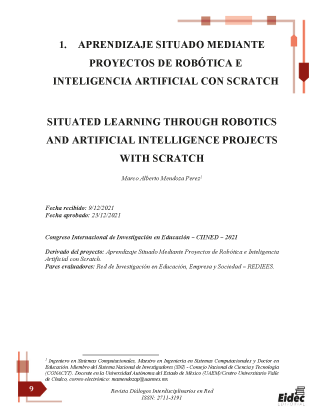I. APRENDIZAJE SITUADO MEDIANTE PROYECTOS DE ROBÓTICA E INTELIGENCIA ARTIFICIAL CON SCRATCH
##plugins.themes.bootstrap3.article.main##
Resumen
A raíz de la Pandemia por COVID-19, las formas de impartir y recibir clases
cambiaron radicalmente. Las asignaturas de Fundamentos de Robótica y de Inteligencia
Artificial forman parte del Mapa Curricular de la carrera de Ingeniería en Computación, que
se imparte en el Centro Universitario (CU) Valle de Chalco, perteneciente a la Universidad
Autónoma del Estado de México (UAEM). Antes de la Pandemia, se enseñaban en el Aula
los contenidos conceptuales de robótica y de inteligencia artificial, y en los Laboratorios de
Electrónica y Control los contenidos procedimentales por medio de la realización de prácticas
y proyectos que contemplaban desde el ensamble hasta la implementación de programas en
los kits de robótica. Actualmente, no es posible utilizarlos, pero se propone utilizar la
Metodología de Aprendizaje Mediante Proyectos, como estrategia de enseñanza-aprendizaje.
Se elaboraron dos secuencias didácticas para clases en línea de Fundamentos de Robótica y
de Inteligencia Artificial; para que los estudiantes adquieran conocimientos, técnicas,
habilidades y destrezas mediante la realización de un proyecto de forma colaborativa en el
lenguaje de programación visual Scratch. En clases en línea de estas dos asignaturas, el
docente explicó como programar aplicaciones en Scratch, posteriormente solicitó a los
estudiantes la elaboración y presentación de un proyecto junto con su documentación y
aplicación de un cuestionario en formulario para conocer los puntos de vista y los
aprendizajes alcanzados por parte de sus compañeros de clase.
Download Statistics
##plugins.themes.bootstrap3.article.details##
Aprendizaje mediante proyectos, Aprendizaje situado, Estrategia de enseñanza-aprendizaje, Fundamentos de Robótica, Inteligencia Artificial, Scratch
interpretación constructiva (3 era. ed.). México: Mc Graw Hill.
Contreras, E. et al. (2013). El concepto de estrategia como fundamento de la
planeación estratégica. Pensamiento & Gestión. Recuperado de
https://www.redalyc.org/pdf/646/64629832007.pdf
Digital Guide IONOS by 1&1 (2020). Programación visual: la entrada más sencilla
al mundo digital. Recuperado de https://shortest.link/26rT
Facultad de Ingeniería de la Universidad Autónoma del Estado de México (2009).
PROGRAMA DE ESTUDIO POR COMPETENCIAS FUNDAMENTOS DE ROBOTICA.
Recuperado de
http://fingenieria.uaemex.mx/portal/docs/coordinaciones/ICO/planF2/Interaccion_H
ombre_Maquina/Fundamentos_de_Robotica.pdf
González, E. (2012). ¿Qué es la Robótica? Recuperado de
https://shirco94.files.wordpress.com/2012/07/que_es_la_robotica.pdf
Mintzberg, A. et al. (1998). Safari a la estrategia. Buenos Aires: Gránica.
Pimienta, J. (2012). Estrategias de enseñanza-aprendizaje. Docencia universitaria
basada en competencias. México: Pearson Educación. Recuperado de
http://prepajocotepec.sems.udg.mx/sites/default/files/estrategias_pimiento_0.pdf
Pozo, E. G. (2005). Técnicas para la Implementación de la Robótica en la Educación
Primaria. Complubot. Recuperado de http://cort.as/-MKKf
Reyes, F. (2011). Robótica. Control de Robots Manipuladores. Primera Edición.
México: Alfaomega.
Scratch (2021). Página oficial de SCRATCH. Recuperado de https://scratch.mit.edu/
Scratch al Sur (2017). SCRATCH AL SUR APRENDIZAJE CREATIVO.
Recuperado de https://www.scratchalsur.org/que-es-scratch.html





